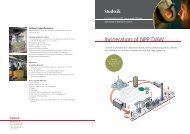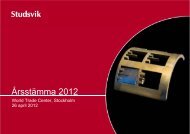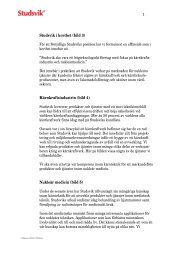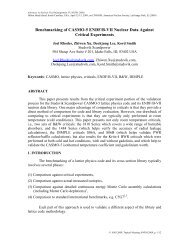Robust PCI Monitoring During PWR Operation at ... - Studsvik
Robust PCI Monitoring During PWR Operation at ... - Studsvik
Robust PCI Monitoring During PWR Operation at ... - Studsvik
- No tags were found...
Create successful ePaper yourself
Turn your PDF publications into a flip-book with our unique Google optimized e-Paper software.
Proceedings of 2010 LWR Fuel Performance/TopFuel/WRFPMOrlando, Florida, USA, September 26-29, 2010Paper 097II. <strong>PCI</strong> ANALYSIS METHODS OVERVIEWFuel performance has long been a part of reload coredesign and analysis. Typically, only bounding analysis ofthe most limiting fuel pins is included in the core designprocess.The difference in the analysis presented here is twofold.First, an actual transient from oper<strong>at</strong>ing reactors th<strong>at</strong>resulted in changes to LHGR is analyzed for margin to<strong>PCI</strong>. Second, since <strong>PCI</strong> is a pin-based phenomenon, allfuel pins in the core are equally analyzed (e.g., nobounding analysis of only limiting pins was used).Fig. 1. Limit<strong>at</strong>ions to delta kW/ft modelThe assessment demonstr<strong>at</strong>es th<strong>at</strong> the various methodsfor examining <strong>PCI</strong> can be applied to actual oper<strong>at</strong>ingevents and screening criteria for bounding analysis is notnecessary.II. A. Delta-kW/ft ModelIn a delta-kW/ft model, changes in linear he<strong>at</strong>gener<strong>at</strong>ion r<strong>at</strong>e (LHGR) between successive calcul<strong>at</strong>ionpoints (st<strong>at</strong>epoints) are examined to ensure the values arewithin acceptable limits. The LHGR values can be nodeaveragedd<strong>at</strong>a, where LHGR's for each pin in an assemblyare normalized within an assembly and divided axially intonodes.The delta-kW/ft model uses the maximum change inLHGR as a potential indic<strong>at</strong>or of a <strong>PCI</strong> viol<strong>at</strong>ion. Thedisadvantage to this approach is th<strong>at</strong> it may ignore arel<strong>at</strong>ively small change in LHGR th<strong>at</strong> could indic<strong>at</strong>e a <strong>PCI</strong>viol<strong>at</strong>ion if the LHGR was already near the limit.Additionally, this approach could incorrectly recognize arel<strong>at</strong>ively large change in LHGR as a potential <strong>PCI</strong> issue,even though the large change occurred in a pin th<strong>at</strong> wasoper<strong>at</strong>ing well below viol<strong>at</strong>ion limits. This is illustr<strong>at</strong>ed inFig. 1.To compens<strong>at</strong>e for these shortcomings, conserv<strong>at</strong>ivevalues for the limiting delta-kW/ft are typically applied.Although this does lend itself to mitig<strong>at</strong>ing <strong>PCI</strong> concernsduring a power maneuver, for example, it can beeconomically inefficient, requiring a slower return topower than is actually needed to preclude <strong>PCI</strong>.The advantage of the delta-kW/ft model is th<strong>at</strong> d<strong>at</strong>a isreadily available from the core simul<strong>at</strong>ion neutronicmodels, with rel<strong>at</strong>ively fast comput<strong>at</strong>ional times.II. B. Threshold LHGR <strong>PCI</strong> ModelA more sophistic<strong>at</strong>ed method of monitoring <strong>PCI</strong> usingLHGR d<strong>at</strong>a is to account for the physical phenomenon ofpin conditioning, the time-dependent annealing th<strong>at</strong> occurswhen a pin LHGR remains <strong>at</strong> the same power for anextended period. By modeling conditioning, gre<strong>at</strong>erchanges in LHGR are achievable without viol<strong>at</strong>ing <strong>PCI</strong>limits, since the pellet and cladding conditioning arefactored into the calcul<strong>at</strong>ion.Fig. 2 presents a graphical depiction of how <strong>at</strong>hreshold model works. The lower dashed line representsthe conditioning threshold. The upper dashed line is the<strong>PCI</strong> viol<strong>at</strong>ion limit, which is a delta above the <strong>PCI</strong>threshold. If, during plant oper<strong>at</strong>ion, a pin LHGR valueexceeds the threshold, "conditioning" begins for th<strong>at</strong> pin.<strong>During</strong> conditioning the threshold increases and, since the<strong>PCI</strong> limit is a fixed delta above the threshold, the <strong>PCI</strong>viol<strong>at</strong>ion limit also increases. Provided the LHGRincreases <strong>at</strong> a r<strong>at</strong>e slow enough to remain below the <strong>PCI</strong>limit, no viol<strong>at</strong>ion occurs. However, if the LHGR changesmore rapidly than the threshold changes, a <strong>PCI</strong> viol<strong>at</strong>ionmay occur.
















